Chapter 12: Mendelian Genetics
Objectives:
From this unit you should be able to:
- understand Mendel's principle of independent assortment
- understand Mendel's principle of gamete formation
- understand Mendel's principle of dominance vs. recessiveness
- understand Mendel's principle of diploidy
- know the expected Mendelian ratios for monohybrid crosses
- know the expected Mendelian ratios for dihybrid crosses
- understand what is meant by sex linkage
- understand what is meant by gene linkage
- understand what is meant by multiple alleles
- understand what is meant by incomplete and codominance
- understand and be able to devise a test cross
- know the terms haploid, diploid, allele, locus
- describe the human karyotype
- understand the role of genetic counseling
- understand nondisjunctions and their consequences
- know what Down's syndrome is
- know what the human genome project is
- have a basic understanding of the molecular biology techniques discussed
Web Text:
- - Historical Background of Inheritance -
- - Mendel's Experiments and Conclusions -
- - Genetic Terms -
- - Application of Mendels Rules: Monohybrid Cross -
- - Application of Mendels Rules: Dihybrid Cross -
- - Complicating Factors -
- - Human Genetics -
- - Chromosomal Disorders -
- - Allelic Disorders -
- - Genetic Testing & Counseling -
- - Some Biotechnology Issues -
Historical background of inheritance - Throughout human history there have been may ideas regarding how we receive or inherit the characteristics we possess. It has long been recognized that similar features were found within families of organisms. But the occurrence of variation posed problems. Well into the 18th and 19th centuries environmental factors were thought to play a significant role in the characteristics of the offspring. Consequently Arabian horses raised in the desert were imported to Britain rather than bred there. Other ideas had our organs producing particles that traveled via the blood to our sex organs, there mixing with fluids from our mate during intercourse and guided by internal molds to produce an offspring.
Along came Gregor Mendel (1822-1884) to this mix. He entered a monastery in Brno, Czechoslovakia ultimately becoming abbot. It was here where he conducted his experiments that led him to his theories of inheritance. For his work, this area of study in biology is referred to as Mendelain genetics.
Mendel's experiments and conclusions - Mendel did something different from his predecessors in his investigations of inheritance. Whether it was his choice of experimental subjects, his knowledge and application of mathematics to the problem, following traits over two generations, presenting his work to the scientific community or just by luck, Mendel and his work are recognized as the foundation of our current understanding of genetic inheritance.
Mendel experimented with garden peas. He had available several varieties of peas which when bred to themselves produced offspring which were always like the parent plant. These are said to be true breeding individuals. These varieties differed in characteristics such as flower color, pea color, pea texture, plant stature, etc. Mendel took these true breeding pea plants and crossed them with each other. He observed the offspring, bred the offspring to each other and then observed what second offspring generation looked like.
For example, one of Mendel's experimental crosses was between true breeding plants, one with a tall stature, the other with a short or dwarf stature. Mendel observed the offspring from this cross to all have the tall stature like the tall parent. He then bred these offspring together. In the next offspring, Mendel observed that the pea plants were of mixed types. Some were of the tall stature while others were dwarf in stature. Mendel counted the numbers of each type. He found that in this generation 787 were of the tall variety and 277 were of the dwarf variety. Mendel recognized this to be a ratio of 2.84 tall individuals for every one dwarf individual. In all of his experiments Mendel found that all of the offspring of the first generation resembled one of the parents while in the second generation of offspring there was a ratio of approximately 3 of one parental type to every 1 of the other parental type.
From these observations, Mendel developed four rules or principles governing the inheritance of traits. These four principles are:
- That traits are determined by unit factors which occur in pairs in individuals.
- That when an individual produced gametes (sperm or eggs), each gamete only receives one of the unit factors for each trait.
- That if the two unit factors in a pair are unalike, one of them is expressed while the other unit factor is masked. The expressed unit factor is said to be dominant while the masked unit factor is said to be recessive.
- Mendel also conducted experiments following two traits at once. He concluded that the unit factors for each trait are inherited independently of one another.
We'll see the application of these principles below.
Genetic terms - We'll be using a number of terms related to genetics in this and future topics. Some of these terms we have already used and other will be used later on.
Chromosome - A complex composed of DNA and proteins which contains genes. Chromosomes are the units of inheritance.
Gene - A segment of DNA on a chromosome which carries the genetic information (DNA sequence) for a trait.
Trait - Any characteristic of an organism which is genetically determined.
Allele - A specific form of a gene.
Locus - The location of a gene along the length of the chromosome.
Genotype - The combination of alleles carried by an individual.
Phenotype - The traits expressed (observable) by an organism.
Diploid - The state in which the cells carry two complete sets of chromosomes.
Haploid - The state in which the cells carry only a single set of chromosomes.
Mitosis - The nuclear/cell division process that results in two genetically identical daughter cells.
Meiosis - The nuclear/cell division process that results in four genetically unique daugher cells which have 1/2 the number of chromosomes as the parent cell.
Homologous chromosomes - Chromosomes which carry genes for the same traits at the same loci however the alleles at these loci may differ.
Application of Mendel's rules: Monohybrid cross - A monohybrid cross is one in which a single trait is followed. The trait we'll follow here is the ability to curl your tongue lengthwise. This ability is controlled by an inherited gene. If you are able to curl your tongue you have at least one copy of the tongue-rolling gene (it is dominant). If you can not roll your tongue you are homozygous for the recessive gene.
Let's say we have a couple which is going to have children. The man has the ability to roll his tongue, all of his ancestors have had this ability so we'll take it as a given that he is homozygous for the tongue rolling alleles. That is, he carries two alleles, both for the ability to roll one's tongue (Mendel's 1st principle). The woman can not roll her tongue. Since we know that this trait is recessive she must be homozygous recessive by definition, carrying two alleles for the inability to roll one's tongue (Mendel's 1st principle).
When the man produces gametes (sperm), each sperm will receive one of the alleles governing the ability to roll one's tongue. Since both alleles the man carries are the same, all of his sperm will carry one allele for the ability to roll one's tongue (Mendel's 2nd principle). Likewise when the woman produces gametes (eggs), each egg will receive one of the two alleles she carries. Since both of the alleles she carries are for the inability to roll one's tongue, all of the eggs she produces will carry one allele for the inability to roll one's tongue.
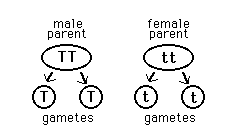
Any children produced from the union of the sperm of this man and this woman's egg will carry one allele for the ability to roll one's tongue (from the father) and one allele for the inability to roll one's tongue (from the mother). This child is said to be heterozygous because the two alleles it carries for this trait are different from one another. According to Mendel's 3rd law, one of these alleles will be expressed (dominant) while the other will be masked (recessive). As it turns out for this particular set of alleles, the one for rolling one's tongue is dominant to the allele for the inability to roll one's tongue. Consequently all the children produced from this couple will have the ability to roll their tongues just like their father.
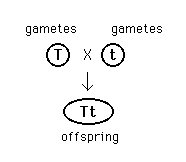
If a child of the above couple encountered another individual who was also heterozygous for the tongue rolling alleles and decided to have children, would the children have the ability to roll their tongues? Let's apply the rules.
When each of these individuals produces gametes, sperm or eggs, the gamete will only receive one of the alleles. Since each of these individuals has one copy of each allele type, half of the gametes will receive alleles for the ability to roll tongues and half will receive the allele for the inability to roll one's tongue.
When an offspring is produced, the gametes unite randomly. It may be that each of the uniting gametes contains the alleles for tongue rolling or it could be that each of the uniting gametes contains the alleles for the inability to roll tongues. Another alternative is that one of the alleles contains the tongue rolling allele while the other allele contains the non-rolling allele.
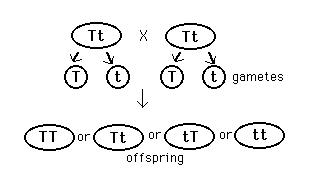
A convenient way to view the possible combination of gametes is to use a device called the punnett square. Here you place the different types of gametes from one parent along one side of the square and the different types of gametes from the other parent along the adjacent side. Lines are drawn through the square separating the different gametes and creating compartments within the square. Then the alleles of the gametes are carried across the rows and down the columns so that each compartment in the square gets one gamete/allele from each parent. Each compartment represents a possible combination of alleles for an offspring.
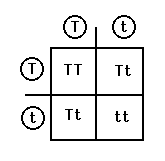
In our example here, one of the four possible combinations is for a homozygous tongue roller, two are for heterozygous tongue rollers, and one is for a homozygous non-roller. Mendel's 3 to 1 ratio.
Application of Mendel's rules: dihybrid cross - If we follow two traits at once, it is referred to as a dihybrid cross. We will use one of Mendel's crosses as an example.
Mendel had a variety of peas that had yellow peas with a smooth texture. He had a second variety of peas that had green peas with a wrinkled texture. These two varieties were crossed. Monohybird experiments revealed that the yellow color was dominant to green and that the smooth texture was dominant to wrinkled. We'll use G and g to represent the yellow and green alleles respectively and W and w to represent the smooth and wrinkled alleles respectively.
The parent which has yellow and smooth peas (genotype GGWW) will produce gametes which contain one copy of the color gene and one of the texture gene. The gametes produced by this parent will contain the alleles G and W.
Likewise, the parent which has the green and wrinkled peas (genotype ggww) will produce gametes with the g and w alleles.
When these individuals cross, their offspring (F1 generation) will have the genotype GgWw. Since yellow and smooth are dominant, all of the offspring will have the yellow/smooth phenotype.
When individuals in the F1 generation produce gametes, each gamete will receive one color gene and one texture gene, but which one? Answer - the alleles will be distributed to the gametes randomly so that you will end up with all possible combinations. Here we will have gametes of the following types: GW, Gw, gW, and gw.
If two individuals of the F1 generation cross, these gametes will come together at random to form the offspring. Here we can use the Punnett Square again to see the possible ways the gametes could combine. Again, the gametes of one parent go along one side while the gametes of the other parent go along the adjacent side.
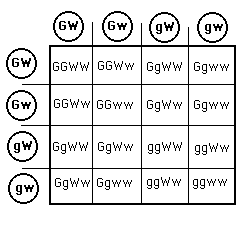
You see there are 16 possible combinations. Several of these combination are identical because it does not matter which parent was the source of the allele. If you determine the phenotype for each genotype, you'll find that 9 of the 16 compartments contain individuals which have both dominant traits (yellow and smooth here), 3 of the 16 have one dominant trait and one recessive trait (yellow and wrinkled), another 3 of 16 have the first recessive and the second dominant (green and smooth) while only 1 of the 16 compartments has the phenotype which is recessive for both traits (green and wrinkled). This 9:3:3:1 ratio in the F2 generation is the expected Mendelian ratio of a dihybrid cross. It result from the independent assortment of the allele during the formation of gametes (Mendel's 4th principle).
Complicating factors - There are several situations in which inheritance patterns don't follow Mendel's four principles. That would make life too simple.
Gene linkage - During the formation of the gametes the chromosomes don't break apart so that the alleles can randomly assort into the sex cells. Rather, the chromosomes go through the orderly process of meiosis to distribute the genetic material into the gametes. Synapsis (prophase I), when crossing-over occurs, accounts for the 'random' assortment alleles. However, if the loci are located close to one another on a chromosome it is unlikely that a crossover event will occur between the genes, consequently the genes tend to be inherited as a unit rather than independently. These genes are said to be linked. The consequence is that in the F2 generation you will not see the expected 9:3:3:1 ratio.
Sex linkage - Sex linkage describes the situation when the gene locus is on the 'X' chromosome. Since females have two of these chromosomes they follow the normal rules. However, males only have a single 'X' chromosome. The other sex chromosome is the Y chromosome. Consequently males don't have a second allele which might mask a recessive allele. Sex-linked phenotypes occur more frequently in males than in females causing a deviation in the expected 3:1 ratio.
Lethal Alleles - Lethal alleles are ones that result in the death of the individual. Most of these are recessive alleles only causing death when homozygous. Most of the time you will not even see these individuals (the 1 in 4 times expected) resulting in a deviation from the expected 3:1 ratio. One of the exceptions to the recessive nature of lethal alleles is the allele for Huntington's disease in humans. This allele does not cause death until the individual reaches their 40s or 50s so they may have had children by that time to pass on the allele.
Incomplete dominance & Codominance - These occur when there is not a strict dominant/recessive interaction between the alleles for a trait.
Incomplete dominance results in an intermediate phenotype when the individual is heterozygous. Flower color in carnations is a good example. The genotype RR results in a red color, the genotype rr results in a white color and the genotype Rr results in a pink color. So instead of the 3:1 expected ratio you have a 1:2:1 (red:pink:white) ratio.
Codominance results the both alleles being expressed at the same time. An example of this occurs in cattle. The genotype RR results in a red coat color, the genotype rr results in a white coat color and the genotype Rr results in the production of both red and white coat hairs (an overall color called roan).
Multiple alleles - Mendel only considered two alleles for each gene, however, we now know that there may be many alleles in a population for a particular trait. These are called multiple alleles. A simple example is in the ABO blood type traits. There are three alleles for blood type, A, B, and O. If you have the genotypes AA or AO, your blood type is A. If you have the genotypes BB or BO, your blood type is B. If you have the genotype OO, your blood type is O. And if you have the genotype AB your blood type is AB. (alleles A and B are codominant to each other while they are dominant to allele O)
Epistasis - Epistasis is the situation in which one gene influences the expression of another gene. Albinism is a good example. Here there is one gene that controls the presence or absence of pigments and there is a second gene that controls the color of the pigment. If the first gene indicates a lack of pigment, it doesn't matter what the second gene holds, no pigment of any color will be produced.
Human Genetics
The human genome consists of approximately 100,000 genes which are distributed on 23 homologous pairs of chromosomes (the diploid number of chromosomes is 46). Of these 23 chromosome pairs, 22 are referred to as autosomal chromosomes, chromosomes that do not determine the sex of the organism. The 23rd chromosome pair consists of the sex chromosomes. Each chromosome pair has a its own physical appearance, recognizable during mitosis and meiosis. The chromosome pairs differ in their size (length) as well as the position of their centromeres. Additional differences can be observed utilizing various chemical treatments that reveal banding patterns along the length of the chromosomes. The physical appearance of an organism's chromosomes is termed the organ's karyotype.
Genetic Problems
In the following discussion of genetic problems that arise in humans it is important to keep in mind that the rules governing Mendelian genetics discussed earlier apply equally to humans as well the other organisms on earth. Generally, amazingly often given the complexity of organisms such as ourselves, our genetic message works pretty well and we are able to pursue our livelihood in 'normal' fashion. However genetic mistakes do occur which impact the quality of one's life. When these mistakes occur, the results are fairly devastating. Genetic mistakes or abnormalities can be placed into one of two categories: chromosomal abnormalities and allelic abnormalities.
Chromosomal abnormalities involve changes in the structure or number of chromosomes in the individual's karyotype. There are several types of chromosomal abnormalities. Inversions occur when a segment of a chromosome gets turned around along the length of the chromosome. Consequently the order of the genes along the chromosome's length is altered. This type of abnormality may interfere with the regulatory mechanisms controlling gene activity. A translocation occurs when a segment of a chromosome is removed from one chromosome and attached to a non-homologous chromosome. Deletions are the loss of a segment of a chromosome while duplications occur when a segment is repeated within a chromosome.
Changes in the chromosome number, a condition termed aneuploidy, may result from an event called a nondisjunction. This occurs when chromosomes fail to separate properly during anaphase I or anaphase II of meiosis. Consequently the individual ends up with either too many chromosomes or too few. Nondisjunctions are generally fatal except when they involve the sex chromosomes or chromosome #21.
Several genetic conditions may occur if one ends up with too many or too few sex chromosomes. If the individual inherits one X chromosome but not a second sex chromosome (genotype XO), the individual is phenotypically female but does not develop mature, functional ovaries. Their body features remain sexually immature unless treated with supplemental hormones. Without mature ovaries they are sterile of course. A person is described as having Klinefelter's syndrome if he inherits two X chromosomes and one Y chromosome (genotype XXY). These individuals are phenotypically male. However they tend to be tall, have small, imperfect testes, and low levels of the male hormone testosterone. Individuals with Klinefelter's syndrome may develop female-like breasts and have body contours that resemble females. If a person inherits three X chromosomes (genotype XXX), the individual is phenotypically female, usually tall and frequently sterile. XYY males have inherited one X chromosome and two Y chromosomes. These individuals are phenotypically male and appear normal except for their extreme height. They are also noted to have severe acne. Studies have suggested that these individuals have lowered IQs and may have increased antisocial behavior as evidenced by a higher frequency of criminal arrest.
If the nondisjunction occurs in one of the autosomes (non-sex chromosomes), the consequences are typically lethal and the individual does not survive embryonic development. An exception to this rule occurs if the nondisjunction occurs with chromosome #21. If an individual inherits 3 copies of chromosome #21 they do survive but suffer from a variety of defects collectively referred to as Down's syndrome. Individuals having Down's syndrome typically have low IQ, folds over the eyes, short stature and short, broad hands.
Allelic disorders: The majority of these alleles result in mild, perhaps annoying problems in the individual. For example, one gene located on the X chromosome is responsible for producing a protein used in the eye for color vision. Individuals who lack a copy of the normal allele and only have this defective allele are said to be red-green colorblind since they have difficulty or are unable to distinguish between these colors. Since the gene is located on the X chromosome, males are more commonly red-green color blind than females as males only have a single copy of the X chromosome.
Tay-Sachs disease is caused by a recessive allele which, when in the homozygous condition, results in blindness and severe mental retardation. Death commonly occurs by the age of five. The gene involved is responsible for producing an enzyme that breaks down membrane lipids in the brain. Without this enzyme the lipid molecules accumulate in the brain cell's lysosomes. At this time there is no effective treatment of Tay-Sachs disease.
Sickle cell anemia occurs in individuals homozygous for an allele that produces an abnormal hemoglobin molecule. In the acidic conditions which occur when blood levels of carbon dioxide are high, the defective hemoglobin molecules stack together causing the red blood cell to take on a sickle shape. These sickled blood cells block capillaries and small blood vessels causing intense pain and damage to the tissues that fail to receive their normal blood supply. An interesting aspect to the sickle cell story is that if a person is heterozygous so that only half their hemoglobin is defective, they appear to be at least partially protected against malaria, a disease caused by a blood parasite. Heterozygotes for the gene normally don't have blood pH levels to create a sickling event, however, if this person's red blood cell is invaded by a malaria parasite, the parasite lowers the cell's pH sufficiently to trigger the cell's sickling. This targets the cell and the parasite inside for destruction by the body's immune system.
Cystic fibrosis is probably the most common recessive genetic disorder in children of European descent. In the United States approximately 1 in every 20 persons is a heterozygote carrier. The gene involved is responsible for producing proteins that transport chloride ions across cell membranes. Individuals who are homozygous for the recessive defective allele are unable to effectively transport chloride ions resulting in the build up a thick mucus which blocks passages of the lungs, pancreas, liver and intestines. Without treatment the individual typically dies in infancy, with medical treatments about 50% of the individuals survive into their early 30s.
Most genetic diseases are inherited as recessive alleles, however, a few are dominant. An example of a dominant defective allele is the one that causes Huntington disease. This disease results in severe mental and physical deterioration, muscle spasms, personality changes and ultimately death. The reason this allele persists in the population is that the onset of the disease symptoms commonly do not occur until the individual's late 30s or into their 40s. There is no treatment for this disease at this time.
Genetic Testing & Counseling
Genetic counseling is discipline in which the professional utilizes Mendelain genetics, what is known about various genetic defects, the laws of probability, and what is known from the family history of a couple to inform the couple when they are making reproductive decisions. The information is presented in the form of probabilities.
You can visit this web site to learn more about the genetic counseling profession.
National Genetic Counselors home page at http://www.nsgc.org/
If a child is conceived, two tests are currently available to test the child for some genetic defects early in the pregnancy. Amniocentesis removes a small quantity of amniotic fluid surrounding the child. This fluid will contain a number of loose cells derived from the child that can be cultured and examined for genetic problems. Chorionic villus sampling (CVS) removes a small tissue sample from the fetal portion of the placenta. These cells have been derived from the zygote so are genetically identical to those of the fetus. When the cells are cultured they can be examined for problems. These tests can be performed sometime between the 11th and 16th week of the pregnancy.
Some Biotechnology Issues
One of the modern methods available to researchers investigating genetics at the molecular level is recombinant DNA technology. Using these mechanisms one is theoretically able to insert or clone any given DNA molecule (containing one or more genes) into an existing organism's genome. Essential to recombinant technology was the discovery of a group of bacterial enzymes called restriction enzymes. These enzymes cleave the DNA molecule at very specific locations.
After being cut, the ends of the DNA molecule will retain their complimentary nature and would recombine spontaneously if left to their own devices. However if other DNA is present which has been cut with the same restriction enzyme, some of that foreign DNA will recombine with the native DNA. Thus the foreign DNA will have been inserted into the original DNA.
You can also use restriction enzymes to compare the DNA from different individuals. Similar DNA will be cut into similar sized fragments by a restriction enzyme. The less similar the DNA the more different the fragments will be. The fragments can be separated using a technique called electrophoresis. Here an electrical current is used to cause the DNA to migrate through a gelatinous material. The smaller fragments move faster than the larger fragments. When the DNA is stained, bands representing the DNA fragments can be observed. DNA fragments that have moved the same distance through the gel are considered to be the same type of DNA fragment.
To investigate or utilize the DNA in some fashion you typically require relatively large amounts of the DNA in question. Two methods of producing the necessary amounts of DNA are available. The method first used utilized living cells to replicate the DNA molecule , in vivo, while the later method replicates in vitro.
The polymerase chain reaction or PCR technique enables one to manufacture millions of copies of a DNA fragment in a few hours. Here the DNA is heated to separate the strands of the double helix and then cooled in the presence of nucleotides, primers and DNA polymerase to create complimentary copies from the separate strands. By repeating this cycle 20 or so times you will create millions of copies of the DNA.